Thanks to Jim Reisert AD1C and Alan Jubb 5B4AHJ for their continuous research and help, WAP has just issued a new Reference to the US Ellsworth Mountains Camp referred to the activity of KC4USW.
First of all, Ellsworth Mountains Camp (WAP USA-NEW) has not to be confused with Ellsworth Station (WAP USA-31) and Ellsworth Base (WAP ARG-14)
KC4USW was QRV from McMurdo Station, Ross Island (WAP USA-22), in 1957 before moving to Ellsworth Mountains Camp, from where he was QRV until February 1959. CQ May 1959 gives the last day of operation from Ellsworth Station as 1959,Febr.1st (letter from W8LIO).
 MARIST Archives & Special Collections has available a recording of an interview with Antarctic explorer Captain Finn Ronne from amateur radio station KC4USW, Weddel Sea, Antarctica, dated 1957, Nov.11.
MARIST Archives & Special Collections has available a recording of an interview with Antarctic explorer Captain Finn Ronne from amateur radio station KC4USW, Weddel Sea, Antarctica, dated 1957, Nov.11.
For sure, QSL of that date (pic on the Left) is a genuine one for Ellsworth Mountains Camp at 79°07’00” South, 85°39’00” West, on Ellswort Mountains, Weddell Sea area (The Weddell Sea is part of the Southern Ocean and contains the Weddell Gyre. Its land boundaries are defined by the bay formed from the coasts of Coats Land and the Antarctic Peninsula. The easternmost point is Cape Norway at Princess Martha Coast, Queen Maud Land. To the east of Cape Norway is the King Haakon VII Sea. Much of the southern part of the sea is covered by a permanent, massive Ice Shelf field, the Filchner Ronne Ice Shelf).
Ellsworth station, the one we know after 1957-1959, was another entity built later , that’s why KC4USW has been used when QRV from Ellsworth Station in 1979-80, and why CQ January 1996 reports KC4USW as QRV from Ellsworth. 1979-80 QSL (tnx ND4V): Note that the 1979/80 QSL shown in Club Log says “Ellsworth Mts (Mountains)”. (See pic on the Right here below)
A bit of history
 (Ellsworth Mountains Camp mistakenly called Ellsworth Station) was built by US Navy Seabees under the command of Capt. Finn Ronne with the support of the Icebreackers USS Staten Island and USS Wyandot.
(Ellsworth Mountains Camp mistakenly called Ellsworth Station) was built by US Navy Seabees under the command of Capt. Finn Ronne with the support of the Icebreackers USS Staten Island and USS Wyandot.
The originally planned site for the station was Cape Adams, but when the terrain proved impractical due to huge ice cliffs, an alternate location on Gould Bay was selected, on the western coast of the Wededell Sea over the Filchner Ice Shelf, and close to the Argentinean Belgrano I Base (WAP ARG-Ø5).
Part of the scheduled agenda for the IGY, Ellsworth Station was commissioned on 11 February 1957 and less than two years later, on 17 January 1959, was handed over to the Argentinean Antarctic Institute. Along with the handover, the United States government gave all the buildings, facilities, and existing food supplies while Argentina provided the logistical and administrative services necessary for the continued operation of the station. It was agreed that scientists of both countries would work together at the place in technical studies and scientific research.
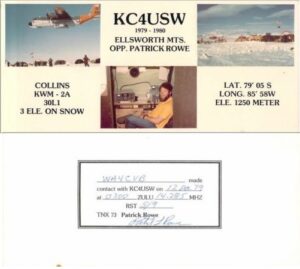 Feasibility of the station came into question when structural problems caused by the unstable ice had the base half-sunken during most of the spring. To protect personnel and equipment, Ellsworth Mountains Camp (mistakenly called Ellsworth Base) was closed and all of its staff and equipment were evacuated on 30 December 1962, during the 1962–63 Antarctic summer campaign. It continued to be inspected periodically by Argentinean exploration teams: it was eventually covered by snow and ice. The Filchner Shelf sector where it was located as split off a giant iceberg, and then it drifted through the Southern Ocean, where the base’s remains have been lost at sea.
Feasibility of the station came into question when structural problems caused by the unstable ice had the base half-sunken during most of the spring. To protect personnel and equipment, Ellsworth Mountains Camp (mistakenly called Ellsworth Base) was closed and all of its staff and equipment were evacuated on 30 December 1962, during the 1962–63 Antarctic summer campaign. It continued to be inspected periodically by Argentinean exploration teams: it was eventually covered by snow and ice. The Filchner Shelf sector where it was located as split off a giant iceberg, and then it drifted through the Southern Ocean, where the base’s remains have been lost at sea.
So, it looks like the Ellsworth Station (WAP-USA-31) and Ellsworth Base (WAP ARG-14) both at 77° 39’ S, 41° 05’ W were the same one. The 1st, the one managed by US, the 2nd managed by LU when it was turned over to Argentina.
Ellsworth Mountain Camp (WAP-USA-NEW) was located at 79°07’S, 85°39’W and it was in activity only from 1957 through 1959.
The ones reported active from 1979-80 and 1996 are referred to Ellsworth Station 77° 39’ S, 41° 05’ W, so, 2 different locations which may confuse a bit.
Following the KC4USW QSL dated 1957, WAP is issuing WAP USA-46 reference to Ellsworth Mountain Camp, 79°07’S, 85°39’W on Ellswort Mountains, Weddell Sea area
TNX Jim AD1C and Alan 5B4AHJ. Note and info on KC4USW have been updated the in Club Log at: https://clublog.org/test.php?call=KC4USW
 The German Research Icebreaker Polarstern with the Call DPØPOL/MM (Op: Andreas, DL3LRM) will be active again in November/December 2021, still on time to join the 60th Anniversary of the Antarctic Treaty Signature. DPØPOL/MM will be WAP-317 and the chasers will get a nice oportunity to collect another brand new WAP reference
The German Research Icebreaker Polarstern with the Call DPØPOL/MM (Op: Andreas, DL3LRM) will be active again in November/December 2021, still on time to join the 60th Anniversary of the Antarctic Treaty Signature. DPØPOL/MM will be WAP-317 and the chasers will get a nice oportunity to collect another brand new WAP reference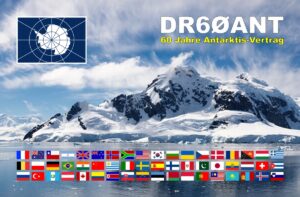

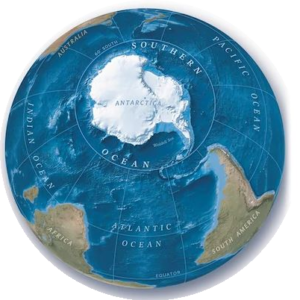 Update your atlas: Southern Ocean recognised as world’s fifth ocean by Nat Geo cartographers
Update your atlas: Southern Ocean recognised as world’s fifth ocean by Nat Geo cartographers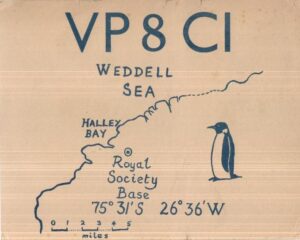 Bill Ashley KF5BRB has sent a very rare QSL of VP8CI, active from Royal Society Base built at 75° 31′ South, 26° 36′ at Halley Bay, West Weddell Sea on January 6th 1956
Bill Ashley KF5BRB has sent a very rare QSL of VP8CI, active from Royal Society Base built at 75° 31′ South, 26° 36′ at Halley Bay, West Weddell Sea on January 6th 1956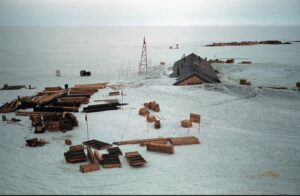
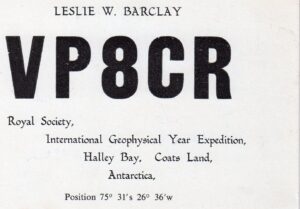
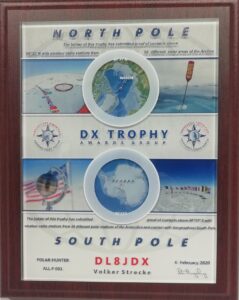 The North Pole & South Pole – DX Trophy (NSP).
The North Pole & South Pole – DX Trophy (NSP). is excited to announce the world-renowned Polar exploration vessel formerly known as MS Hanseatic and Society Adventurer will be joining the fleet from May 2022.
is excited to announce the world-renowned Polar exploration vessel formerly known as MS Hanseatic and Society Adventurer will be joining the fleet from May 2022.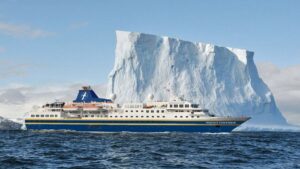 Built in 1991 at Finland’s Rauma shipyard and specifically designed for Polar exploration, Heritage Adventurer is 124-metres long, boasts a 1A Super ice class and an impressive history of Polar and remote region exploration.
Built in 1991 at Finland’s Rauma shipyard and specifically designed for Polar exploration, Heritage Adventurer is 124-metres long, boasts a 1A Super ice class and an impressive history of Polar and remote region exploration. The Antarctic Treaty System (ATS) was entered into force in 1961. So this year it’s the 60th Anniversary.
The Antarctic Treaty System (ATS) was entered into force in 1961. So this year it’s the 60th Anniversary.  MARIST Archives & Special Collections has available a recording of an interview with Antarctic explorer Captain Finn Ronne from amateur radio station KC4USW, Weddel Sea, Antarctica, dated 1957, Nov.11.
MARIST Archives & Special Collections has available a recording of an interview with Antarctic explorer Captain Finn Ronne from amateur radio station KC4USW, Weddel Sea, Antarctica, dated 1957, Nov.11. (Ellsworth Mountains Camp mistakenly called Ellsworth Station) was built by US Navy Seabees under the command of Capt. Finn Ronne with the support of the Icebreackers USS Staten Island and USS Wyandot.
(Ellsworth Mountains Camp mistakenly called Ellsworth Station) was built by US Navy Seabees under the command of Capt. Finn Ronne with the support of the Icebreackers USS Staten Island and USS Wyandot. Feasibility of the station came into question when structural problems caused by the unstable ice had the base half-sunken during most of the spring. To protect personnel and equipment, Ellsworth Mountains Camp (mistakenly called Ellsworth Base) was closed and all of its staff and equipment were evacuated on 30 December 1962, during the 1962–63 Antarctic summer campaign. It continued to be inspected periodically by Argentinean exploration teams: it was eventually covered by snow and ice. The Filchner Shelf sector where it was located as split off a giant iceberg, and then it drifted through the Southern Ocean, where the base’s remains have been lost at sea.
Feasibility of the station came into question when structural problems caused by the unstable ice had the base half-sunken during most of the spring. To protect personnel and equipment, Ellsworth Mountains Camp (mistakenly called Ellsworth Base) was closed and all of its staff and equipment were evacuated on 30 December 1962, during the 1962–63 Antarctic summer campaign. It continued to be inspected periodically by Argentinean exploration teams: it was eventually covered by snow and ice. The Filchner Shelf sector where it was located as split off a giant iceberg, and then it drifted through the Southern Ocean, where the base’s remains have been lost at sea.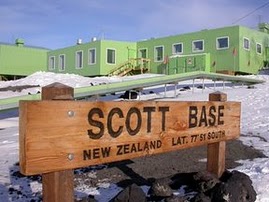 A budget plan includes $344 million New Zealand dollars (US $247 million) to rebuild Scott Base
A budget plan includes $344 million New Zealand dollars (US $247 million) to rebuild Scott Base 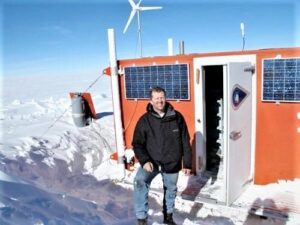 Sad to recently learn that Andy Stillinger (WA2DKJ/KC4) died suddenly of natural causes this pass February 23, 2021
Sad to recently learn that Andy Stillinger (WA2DKJ/KC4) died suddenly of natural causes this pass February 23, 2021 the end of January in Antarctica operating from McMurdo Station (KC4USV)
the end of January in Antarctica operating from McMurdo Station (KC4USV) 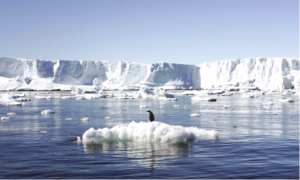 Scientists from Te Herenga Waka—Victoria University of Wellington’s Te Puna Pātiotio—Antarctic Research Centre (ARC) have contributed to a major international study that has found sea level rise from melting glaciers and ice sheets could be halved this century if the Paris Agreement target of limiting warming to 15°C is met.
Scientists from Te Herenga Waka—Victoria University of Wellington’s Te Puna Pātiotio—Antarctic Research Centre (ARC) have contributed to a major international study that has found sea level rise from melting glaciers and ice sheets could be halved this century if the Paris Agreement target of limiting warming to 15°C is met. Station “P” was a British base camp at the head of Mateev Cove on the east side of Hannah Point, 62°39’16”South, 60°36’48” West on Livingston Island in the South Shetland Islands, Antarctica that supported survey, geology and biology field work, from 29 December 1957 until 15 March 1958. It was a temporary, mobile camp for use by field parties on Livingston Island. It has not been the practice to assign letters to field camps, so the letter “P” was used as the intention had been to erect a Hut. RRS Shackleton was holed when transporting the Hut, parts of which were used to repair the ship.
Station “P” was a British base camp at the head of Mateev Cove on the east side of Hannah Point, 62°39’16”South, 60°36’48” West on Livingston Island in the South Shetland Islands, Antarctica that supported survey, geology and biology field work, from 29 December 1957 until 15 March 1958. It was a temporary, mobile camp for use by field parties on Livingston Island. It has not been the practice to assign letters to field camps, so the letter “P” was used as the intention had been to erect a Hut. RRS Shackleton was holed when transporting the Hut, parts of which were used to repair the ship.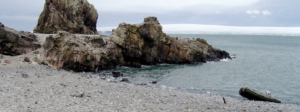
 The Antarctic Treaty System is the whole complex of arrangements made for the purpose of regulating relations among states in the Antarctic. At its heart is the Antarctic Treaty itself. The original Parties to the Treaty were the 12 nations active in the Antarctic during the International Geophysical Year of 1957-58.
The Antarctic Treaty System is the whole complex of arrangements made for the purpose of regulating relations among states in the Antarctic. At its heart is the Antarctic Treaty itself. The original Parties to the Treaty were the 12 nations active in the Antarctic during the International Geophysical Year of 1957-58.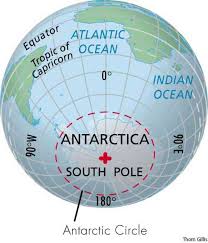 Research led by the University of Kent’s School of Physical Sciences has found new evidence of a low-altitude meteoritic touchdown event reaching the Antarctic ice sheet 430,000 years ago.
Research led by the University of Kent’s School of Physical Sciences has found new evidence of a low-altitude meteoritic touchdown event reaching the Antarctic ice sheet 430,000 years ago.
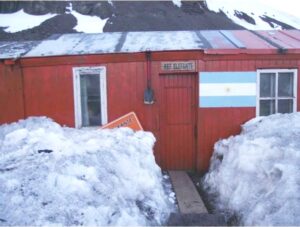 Rifugio Elefante is an Antarctic refuge located in the ice-free area at the foot of Fourcade glacier (62° 15’ 18″ South, 58° 37′ 56″ West) is located about 1000 mts from Punta Stranger,on the Potter peninsula of King George Island.
Rifugio Elefante is an Antarctic refuge located in the ice-free area at the foot of Fourcade glacier (62° 15’ 18″ South, 58° 37′ 56″ West) is located about 1000 mts from Punta Stranger,on the Potter peninsula of King George Island.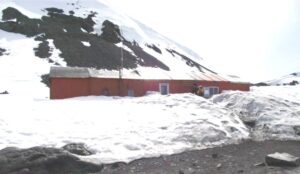 stepped on the Antarctic, did install on the site, an autonomous system that would provide energy to the “Elephant Refuge” located 2.6 km northwest of Carlini Base (WAP ARG-2Ø) of the Argentine Antarctic Institute.
stepped on the Antarctic, did install on the site, an autonomous system that would provide energy to the “Elephant Refuge” located 2.6 km northwest of Carlini Base (WAP ARG-2Ø) of the Argentine Antarctic Institute. Sad news forwarded by Bhagwati VU3BPZ (8T2BH-AT1ØBPR).
Sad news forwarded by Bhagwati VU3BPZ (8T2BH-AT1ØBPR). Dr. Eddy De Busschere is the Secretary of the Belgian Polar Exploration Society (BPES).
Dr. Eddy De Busschere is the Secretary of the Belgian Polar Exploration Society (BPES).
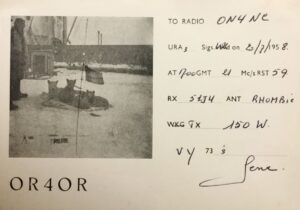 He said: « Jean Hooghewys OR4OR is no longer with us and I cannot contact his family to find out if any cards are left. It is the only card I am still missing from the Belgian Antarctic base 1957-1967. I think I have all the others. The only person that has such a card is Ghis Penny (ON5NT). May be there is someone able to offer me such a card. I keep my fingers crossed.
He said: « Jean Hooghewys OR4OR is no longer with us and I cannot contact his family to find out if any cards are left. It is the only card I am still missing from the Belgian Antarctic base 1957-1967. I think I have all the others. The only person that has such a card is Ghis Penny (ON5NT). May be there is someone able to offer me such a card. I keep my fingers crossed.

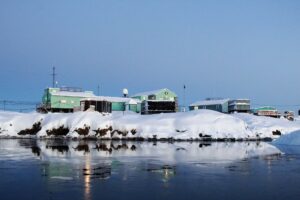 “The 26th Ukrainian Antarctic Expedition left for the Vernadsky Research Base (WAP UKR-Ø1) on March 24. Researchers will spend approximately 13 months in Antarctica,” the National Antarctic Science Center press office informs.
“The 26th Ukrainian Antarctic Expedition left for the Vernadsky Research Base (WAP UKR-Ø1) on March 24. Researchers will spend approximately 13 months in Antarctica,” the National Antarctic Science Center press office informs.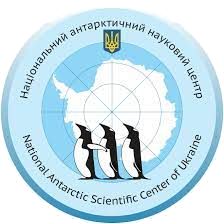 In total, the expedition includes 12 participants: 7 scientists, a doctor, a cook, a diesel engineer, a system mechanic and a system administrator. Of these, 11 men and one woman, a biologist Oksana Savenko, is going to the Base for the second time. This is also a record as no other woman had wintered twice before.
In total, the expedition includes 12 participants: 7 scientists, a doctor, a cook, a diesel engineer, a system mechanic and a system administrator. Of these, 11 men and one woman, a biologist Oksana Savenko, is going to the Base for the second time. This is also a record as no other woman had wintered twice before. The Atmospheric Research Observatory (ARO) at the Amundsen-Scott South Pole Station (WAP USA-21) is a National Science Foundation (NSF) facility located near the geographic South Pole. The NSF has allocated ARO to a long-term research program conducted by the National Oceanic and Atmospheric Administration’s Global Monitoring Division (NOAA/OAR/ESRL/GMD).
The Atmospheric Research Observatory (ARO) at the Amundsen-Scott South Pole Station (WAP USA-21) is a National Science Foundation (NSF) facility located near the geographic South Pole. The NSF has allocated ARO to a long-term research program conducted by the National Oceanic and Atmospheric Administration’s Global Monitoring Division (NOAA/OAR/ESRL/GMD).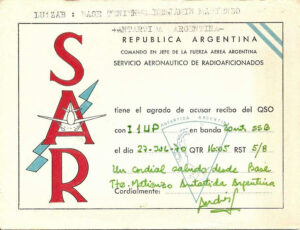 Matienzo Base 64° 50’ South, 60° 07’ West (Base Aérea Teniente Benjamín Matienzo)
Matienzo Base 64° 50’ South, 60° 07’ West (Base Aérea Teniente Benjamín Matienzo) 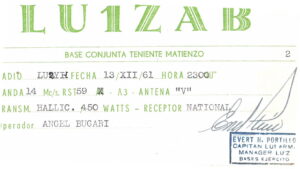
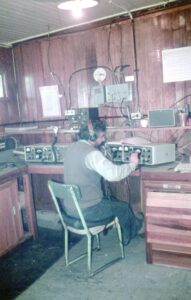 After the kitchen, the Radio Station was our second meeting place. While in the first one we met to fraternize, make comments, tell jokes and have a few bitter ones enjoying the occurrences of our cook, the Radio Station was the obligatory point of attendance to listen and find out the latest news and communicate through the networks established to make official links and also to get in touch with our loved ones.
After the kitchen, the Radio Station was our second meeting place. While in the first one we met to fraternize, make comments, tell jokes and have a few bitter ones enjoying the occurrences of our cook, the Radio Station was the obligatory point of attendance to listen and find out the latest news and communicate through the networks established to make official links and also to get in touch with our loved ones.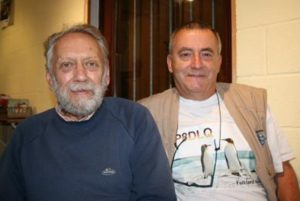 Pic aside shows Roger ON4TX/OR4TX to the left with ON5NT Ghis
Pic aside shows Roger ON4TX/OR4TX to the left with ON5NT Ghis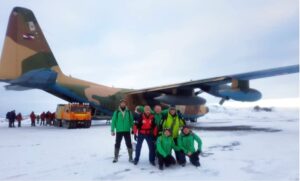 Six Bulgarian polar explorers: Yordan Todorov, Petar Sapundzhiev, Emil Ivanov, Nikolay Nikolov, Kamen Nedkov and the doctor Dr. Atanas Peltekov, after about a month of delay, on April 14 2021, left the Antarctic region and, by a Uruguayan military plane arrived in the southernmost Chilean city of Punta Arenas.
Six Bulgarian polar explorers: Yordan Todorov, Petar Sapundzhiev, Emil Ivanov, Nikolay Nikolov, Kamen Nedkov and the doctor Dr. Atanas Peltekov, after about a month of delay, on April 14 2021, left the Antarctic region and, by a Uruguayan military plane arrived in the southernmost Chilean city of Punta Arenas.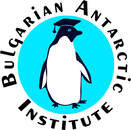 activities. Damage to facilities and buildings on the base caused by high winds during the time when no one was on the base was repaired and it was conserved for the coming winter. The site was prepared for the construction of the new laboratory block, a special hangar was built for the incinerator, which burns the waste ecologically, and all the data were taken from the year-round scientific equipment, which records climatic, seismic, mareographic and glaciological events, in the area when the base is not inhabited” said Prof. Dr. Hristo Pimpirev, head of all Bulgarian polar expeditions and director of the Bulgarian Antarctic Institute.
activities. Damage to facilities and buildings on the base caused by high winds during the time when no one was on the base was repaired and it was conserved for the coming winter. The site was prepared for the construction of the new laboratory block, a special hangar was built for the incinerator, which burns the waste ecologically, and all the data were taken from the year-round scientific equipment, which records climatic, seismic, mareographic and glaciological events, in the area when the base is not inhabited” said Prof. Dr. Hristo Pimpirev, head of all Bulgarian polar expeditions and director of the Bulgarian Antarctic Institute.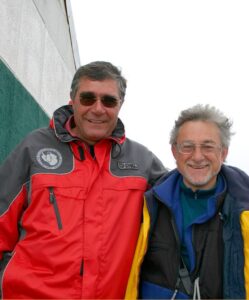 Prof. Hristo Pimpirev, together with Javier Cacho, a Spanish scientist physicist , recently received the “Unifier of Cultures” award in the eighth “Worlds and Colors” contest, organized by the Association of Spanish speaking Journalists in Bulgaria. (pic to the left)
Prof. Hristo Pimpirev, together with Javier Cacho, a Spanish scientist physicist , recently received the “Unifier of Cultures” award in the eighth “Worlds and Colors” contest, organized by the Association of Spanish speaking Journalists in Bulgaria. (pic to the left) The Hams worldwide, thanks Dr. Pavlo Tarasovych UT1KY, Antarctic veteran for issuing a special Award to the radio amateurs who worked the special callsign EM25VER, issued to celebrate the 25th Anniversary of the Ukrainian Research Station Akademik Vernadsky (WAP UKR-Ø1) in Antarctica. Hams wishing to get the Award could write to Pavlo (
The Hams worldwide, thanks Dr. Pavlo Tarasovych UT1KY, Antarctic veteran for issuing a special Award to the radio amateurs who worked the special callsign EM25VER, issued to celebrate the 25th Anniversary of the Ukrainian Research Station Akademik Vernadsky (WAP UKR-Ø1) in Antarctica. Hams wishing to get the Award could write to Pavlo (
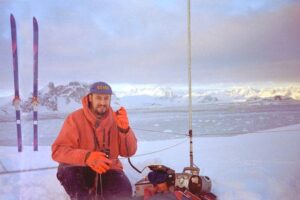
 Ale Antarctic Logistics & Expeditions manage several sites in Antarctica. One of those, is Union Glacier Camp at 79˚46’South, 82˚52’West, located in Ellsworth Land in Antarctica.
Ale Antarctic Logistics & Expeditions manage several sites in Antarctica. One of those, is Union Glacier Camp at 79˚46’South, 82˚52’West, located in Ellsworth Land in Antarctica.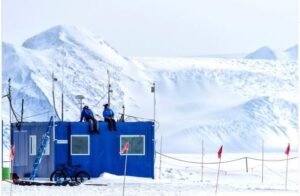
 Christchurch in the Southern Island of New Zealand is an outpost, an ideal location to jump down South, in Antarctica.
Christchurch in the Southern Island of New Zealand is an outpost, an ideal location to jump down South, in Antarctica.  The role of the Christchurch Antarctic Office is to co-ordinate the opportunities presented by Christchurch’s Antarctic Gateway status and to explore our historic and modern connections with the icy continent.
The role of the Christchurch Antarctic Office is to co-ordinate the opportunities presented by Christchurch’s Antarctic Gateway status and to explore our historic and modern connections with the icy continent. has flowed through Christchurch, starting over 100 years ago with the “Heroic Era” explorations of Captain Robert Falcon Scott and Sir Ernest Shackleton, who both used Christchurch as a base camp for their Antarctic expeditions».
has flowed through Christchurch, starting over 100 years ago with the “Heroic Era” explorations of Captain Robert Falcon Scott and Sir Ernest Shackleton, who both used Christchurch as a base camp for their Antarctic expeditions».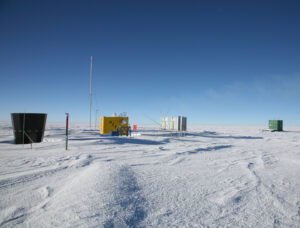
 Dome A nearest Base is the Chinese. Kunlun Station located at 80° 25’ 01”South, 77° 06’ 58” East (WAP CHN-NEW), the only Base there around.
Dome A nearest Base is the Chinese. Kunlun Station located at 80° 25’ 01”South, 77° 06’ 58” East (WAP CHN-NEW), the only Base there around.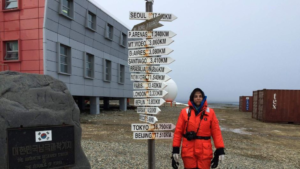 In a recent mail (April 2 2021) Lee Sang Hon (DS4MNJ) informs that antenna for 80m~10m is installed and now he is ready for FT8 and CW. SSB is possible but it is only for contest or request.
In a recent mail (April 2 2021) Lee Sang Hon (DS4MNJ) informs that antenna for 80m~10m is installed and now he is ready for FT8 and CW. SSB is possible but it is only for contest or request.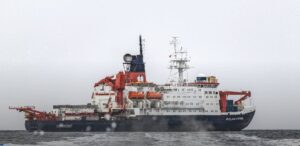 Polarstern from Stanley on the Falkland Islands to the home port of Bremerhaven begins last, Friday, April 2,
Polarstern from Stanley on the Falkland Islands to the home port of Bremerhaven begins last, Friday, April 2,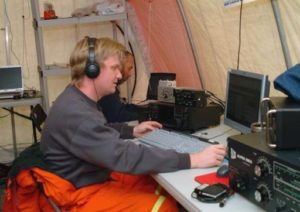 Among them is Felix, DL5XL, who has been very active on the bands in the past few months under DP0GNV from the Neumayer III Research Station (WAP DEU-Ø8) and under DP0POL/MM from on board the Polarstern. Together with Theresa, DC1TH, he made it possible for many radio amateurs to have very special radio contact via QO-100 or on shortwave in his limited free time; we reported several times.
Among them is Felix, DL5XL, who has been very active on the bands in the past few months under DP0GNV from the Neumayer III Research Station (WAP DEU-Ø8) and under DP0POL/MM from on board the Polarstern. Together with Theresa, DC1TH, he made it possible for many radio amateurs to have very special radio contact via QO-100 or on shortwave in his limited free time; we reported several times. While the situation is slightly different today, the celebrations will also change in the pandemic. But that does not mean one cannot spread positivity and warmth on this day.
While the situation is slightly different today, the celebrations will also change in the pandemic. But that does not mean one cannot spread positivity and warmth on this day.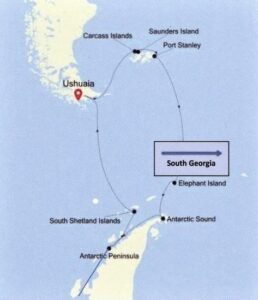 The voyage of the National Geographic Orion from February 16, to March 7, 2016, followed the map counterclockwise. The purpose of the trip was exploration of the Antarctic Peninsula by ship and on land, and commemoration of the 100th anniversary of Earnest Shackleton’s near disastrous voyage to Antarctica and ultimate rescue, 1914 — 1917.
The voyage of the National Geographic Orion from February 16, to March 7, 2016, followed the map counterclockwise. The purpose of the trip was exploration of the Antarctic Peninsula by ship and on land, and commemoration of the 100th anniversary of Earnest Shackleton’s near disastrous voyage to Antarctica and ultimate rescue, 1914 — 1917.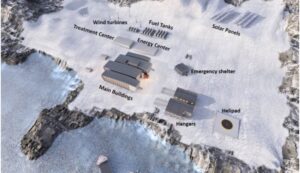 The planned Turkish Antarctic Research Station (TARS) is to be built in the southern part of the Antarctic Peninsula on Horseshoe Island. Between 24 and 50 people are to be accommodated in the station, which is to operate all year round. The graphic shows the various buildings and structures planned. (picture aside)
The planned Turkish Antarctic Research Station (TARS) is to be built in the southern part of the Antarctic Peninsula on Horseshoe Island. Between 24 and 50 people are to be accommodated in the station, which is to operate all year round. The graphic shows the various buildings and structures planned. (picture aside) United Kingdom to the Antarctic Treaty Consulttive Meeting.
United Kingdom to the Antarctic Treaty Consulttive Meeting.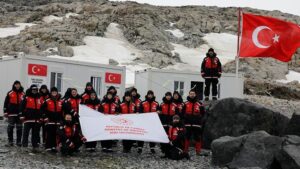 Turkey is one of the youngest Antarctic nations and is hitting the accelerator. A first Antarctic expedition with Turkish participation was launched in 2016 together with Ukraine.
Turkey is one of the youngest Antarctic nations and is hitting the accelerator. A first Antarctic expedition with Turkish participation was launched in 2016 together with Ukraine. Located at 66°14’59” South, 100°36’12” East, Edgeworth David is a summer-only Station, a research outpost named after Sir Edgeworth David.
Located at 66°14’59” South, 100°36’12” East, Edgeworth David is a summer-only Station, a research outpost named after Sir Edgeworth David. geophisical, geomorphologogical and biological research.
geophisical, geomorphologogical and biological research. Pakistani researchers are keen to revive scientific exploration in the Antarctic region. Officials have expressed a desire to revitalize expeditions in Antarctica by Pakistani scientists in collaboration with friendly countries.
Pakistani researchers are keen to revive scientific exploration in the Antarctic region. Officials have expressed a desire to revitalize expeditions in Antarctica by Pakistani scientists in collaboration with friendly countries. Jinnah Antarctic Station
Jinnah Antarctic Station 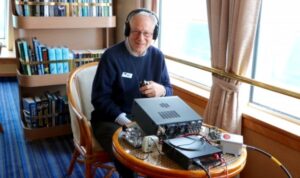 activity as VP8DPC/m and C6AMD/mm.
activity as VP8DPC/m and C6AMD/mm.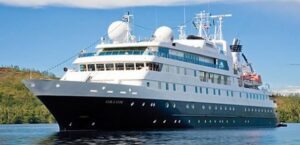
 Starting October 15, 1956, the Soviet Union built a Scientific Station by the name of Oazis (Оазис) at the shore of the Algae (Figurnoje) Lake in the center of Bunger Lakes or Bunger Oasis’s area. The Oazis Base located at 66° 16′ 29″ South, 100° 44′ 49″ East, consisting of two wooden houses ca. 20 m2 each and a few smaller buildings, was able to accommodate eight people. The station was handed over by the Soviet Accademy of Sciences to Poland on January 23, 1959, and was renamed Antoni B. Dobrowolski Station. It continued to be occupied for a few weeks only thereafter.
Starting October 15, 1956, the Soviet Union built a Scientific Station by the name of Oazis (Оазис) at the shore of the Algae (Figurnoje) Lake in the center of Bunger Lakes or Bunger Oasis’s area. The Oazis Base located at 66° 16′ 29″ South, 100° 44′ 49″ East, consisting of two wooden houses ca. 20 m2 each and a few smaller buildings, was able to accommodate eight people. The station was handed over by the Soviet Accademy of Sciences to Poland on January 23, 1959, and was renamed Antoni B. Dobrowolski Station. It continued to be occupied for a few weeks only thereafter. The still in place magnetic observatory building (“Oasis Station Observatory”), along with a plaque commemorating the establishment of Oasis Station in 1956, has been designated a Historic Site or Monument (HSM 10) following a proposal by Russia to the Antarctic Treaty Consultative Meeting (ATCM).
The still in place magnetic observatory building (“Oasis Station Observatory”), along with a plaque commemorating the establishment of Oasis Station in 1956, has been designated a Historic Site or Monument (HSM 10) following a proposal by Russia to the Antarctic Treaty Consultative Meeting (ATCM). Here is a testimony told by Jorge Canova, pilot of the Argentine Air Force who is sharing the image of Nuestra Señora de Loreto enthroned at Matienzo Base during the 1970/71 Antarctic campaign.
Here is a testimony told by Jorge Canova, pilot of the Argentine Air Force who is sharing the image of Nuestra Señora de Loreto enthroned at Matienzo Base during the 1970/71 Antarctic campaign. Here below, just some of the comments coming from participants:
Here below, just some of the comments coming from participants: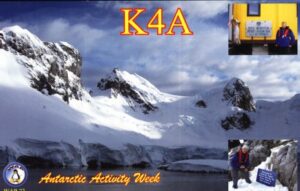

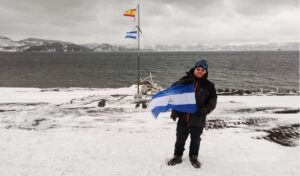 This 34-year-old is the first Nicaraguan at the “Gabriel de Castilla Base” (WAP ESP-Ø2), one of the two Spanish bases located on Decepción Island in the South Shetland Islands Archipelago, in Antarctica. There he saw how the Spanish military placed the flag of Nicaragua on the flagpole, along with that of Spain, a gesture that shocked him and filled him with pride.
This 34-year-old is the first Nicaraguan at the “Gabriel de Castilla Base” (WAP ESP-Ø2), one of the two Spanish bases located on Decepción Island in the South Shetland Islands Archipelago, in Antarctica. There he saw how the Spanish military placed the flag of Nicaragua on the flagpole, along with that of Spain, a gesture that shocked him and filled him with pride.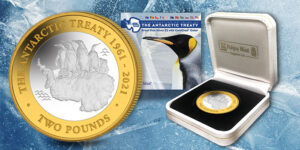 The entry into force of the Antarctic Treaty is recognized as one of the most successful international agreements, setting an example of peaceful cooperation, designated as a “natural reserve, devoted to peace and science”.
The entry into force of the Antarctic Treaty is recognized as one of the most successful international agreements, setting an example of peaceful cooperation, designated as a “natural reserve, devoted to peace and science”. Sometimes, as in this case, Arctic and Antarctica are joined together in the bound by the invisible wire of radio waves . That WNP-WAP printed on a very old QSL card intrigues me a lot.
Sometimes, as in this case, Arctic and Antarctica are joined together in the bound by the invisible wire of radio waves . That WNP-WAP printed on a very old QSL card intrigues me a lot. My father would have been 17 years of age at that time and his Ham activity is summarized as follows: The American Radio Relay League Amateur 5AFD 12/7/1925 to 12/31/1926 (his old QSL card on the right), then W5AFD 1/8/1932 to 1/7/1933 and W6KQX6 1/7/1946 to 6/7/1951. Later he was N6AHY»
My father would have been 17 years of age at that time and his Ham activity is summarized as follows: The American Radio Relay League Amateur 5AFD 12/7/1925 to 12/31/1926 (his old QSL card on the right), then W5AFD 1/8/1932 to 1/7/1933 and W6KQX6 1/7/1946 to 6/7/1951. Later he was N6AHY» Arctic Expedition 1925. The card was issued from contact at Etah, Greenland, but based upon the postage stamp it was mailed in Canada.
Arctic Expedition 1925. The card was issued from contact at Etah, Greenland, but based upon the postage stamp it was mailed in Canada.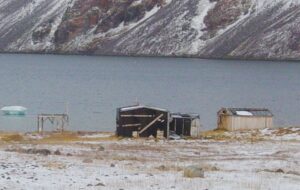
 Well, if we were to go to Antarctica, we’d also find a small image of Don Bosco there too. This photo was taken 15,073 kilometers from Spain as Don Bosco is present as patron of the military contingent that accompanies environmental researchers on the Antarctic Continent.
Well, if we were to go to Antarctica, we’d also find a small image of Don Bosco there too. This photo was taken 15,073 kilometers from Spain as Don Bosco is present as patron of the military contingent that accompanies environmental researchers on the Antarctic Continent.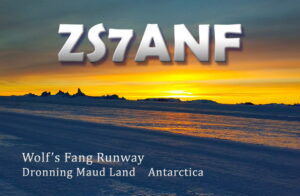 For those who had not yet the luck to work Oleg, ZS7ANF from the Wolf´s Fang Runway, would be useful to know that he is almost every day in the evening hours on 10115 (+/-) in CW.
For those who had not yet the luck to work Oleg, ZS7ANF from the Wolf´s Fang Runway, would be useful to know that he is almost every day in the evening hours on 10115 (+/-) in CW. It is particularly worthy of note that the WhichAway Camp (built in 2010) is in the Schirmacher Oasis at the Lake Podprudnoje at 70° 45′ 49″ South, 11° 36′59″ East,
It is particularly worthy of note that the WhichAway Camp (built in 2010) is in the Schirmacher Oasis at the Lake Podprudnoje at 70° 45′ 49″ South, 11° 36′59″ East, 
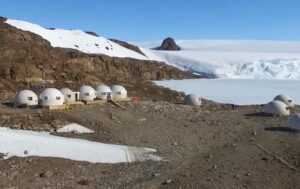
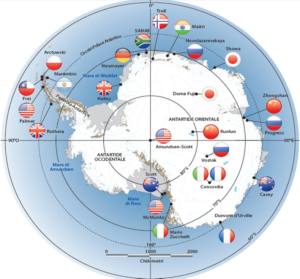 Antarctica
Antarctica 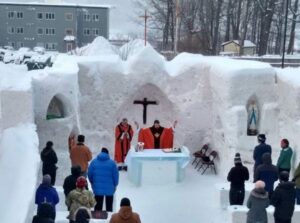 The news reporting the build of an “Ice Chapel” outside St. Albert The Great Parish on Michigan Tech’s campus, (see picture aside) reminds us the Ice chapel carved into the ice at the Argentine Base of Belgrano II (WAP ARG-Ø6) in Antarctica!
The news reporting the build of an “Ice Chapel” outside St. Albert The Great Parish on Michigan Tech’s campus, (see picture aside) reminds us the Ice chapel carved into the ice at the Argentine Base of Belgrano II (WAP ARG-Ø6) in Antarctica!
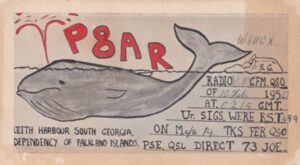 Thanks to Mehdi F5PFP for having shown an old QSL card of VP8AR who did operate from Leith Haurbour in 1950,
Thanks to Mehdi F5PFP for having shown an old QSL card of VP8AR who did operate from Leith Haurbour in 1950,  WAP
WAP  Thanks to Joe De Gasperin I2YDX a keen Dxer and Antarctic Chaser for submitting a rare and old QSL of the
Thanks to Joe De Gasperin I2YDX a keen Dxer and Antarctic Chaser for submitting a rare and old QSL of the  25 years ago, February 6th 1996, Ukraine took over the operation at Base Faraday (or Base F), WAP GBR-Ø7 of the United Kingdom which was sold by the UK for a symbolic one pound. The cost of disassembling the base with good environmental practices and standards would have been too costly.
25 years ago, February 6th 1996, Ukraine took over the operation at Base Faraday (or Base F), WAP GBR-Ø7 of the United Kingdom which was sold by the UK for a symbolic one pound. The cost of disassembling the base with good environmental practices and standards would have been too costly.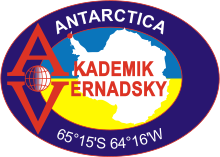
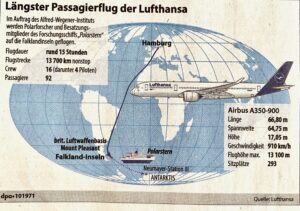 Yesterday, Jan. 31, 2021 another group of German scientists did fly with an Airbus A350-900 directly from Hamburg to Port Stanley, Falklands. There they will be picked up by the Research Icebreaker Polarstern in order to conduct research projects in the Weddel Sea.
Yesterday, Jan. 31, 2021 another group of German scientists did fly with an Airbus A350-900 directly from Hamburg to Port Stanley, Falklands. There they will be picked up by the Research Icebreaker Polarstern in order to conduct research projects in the Weddel Sea.